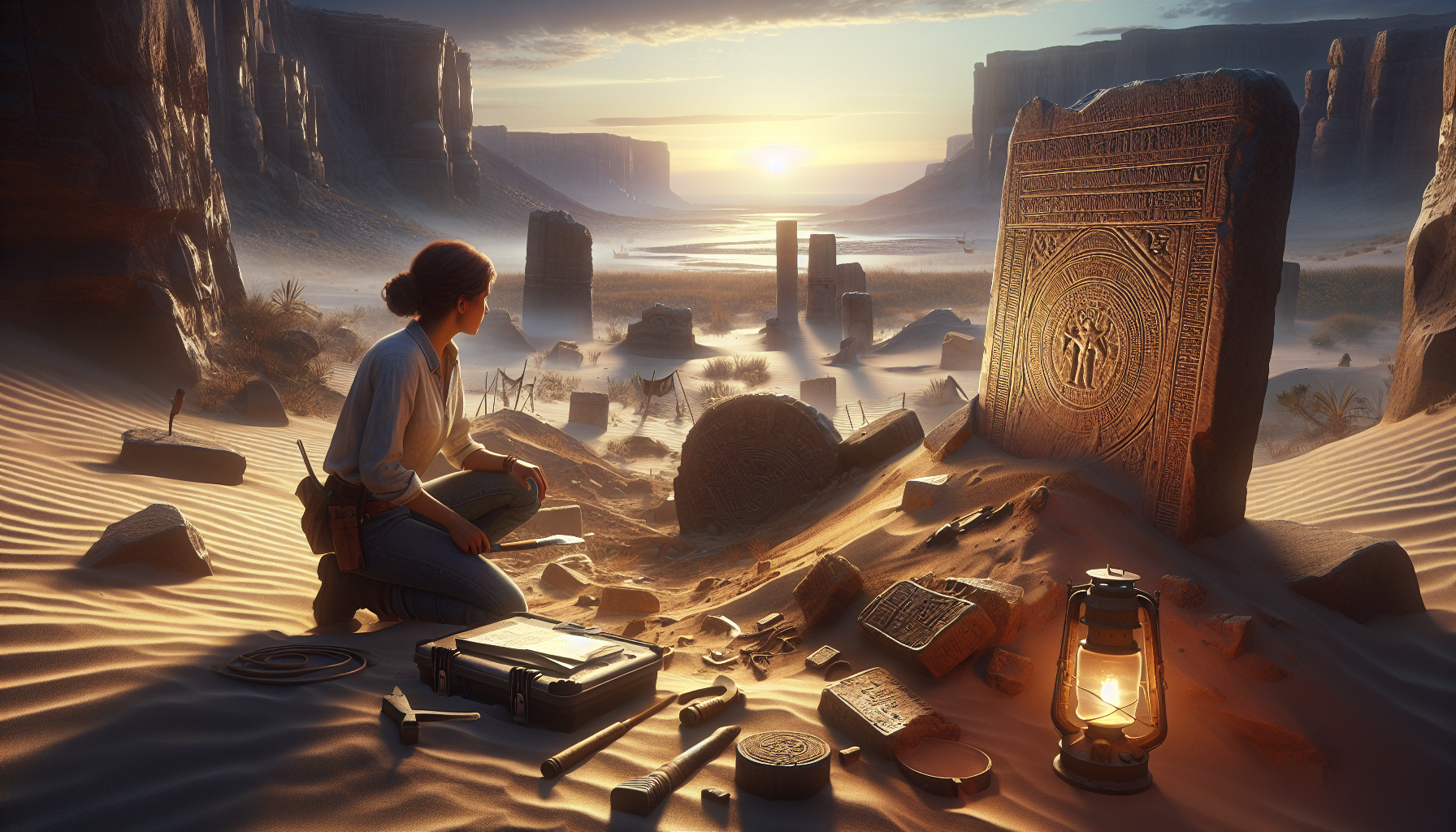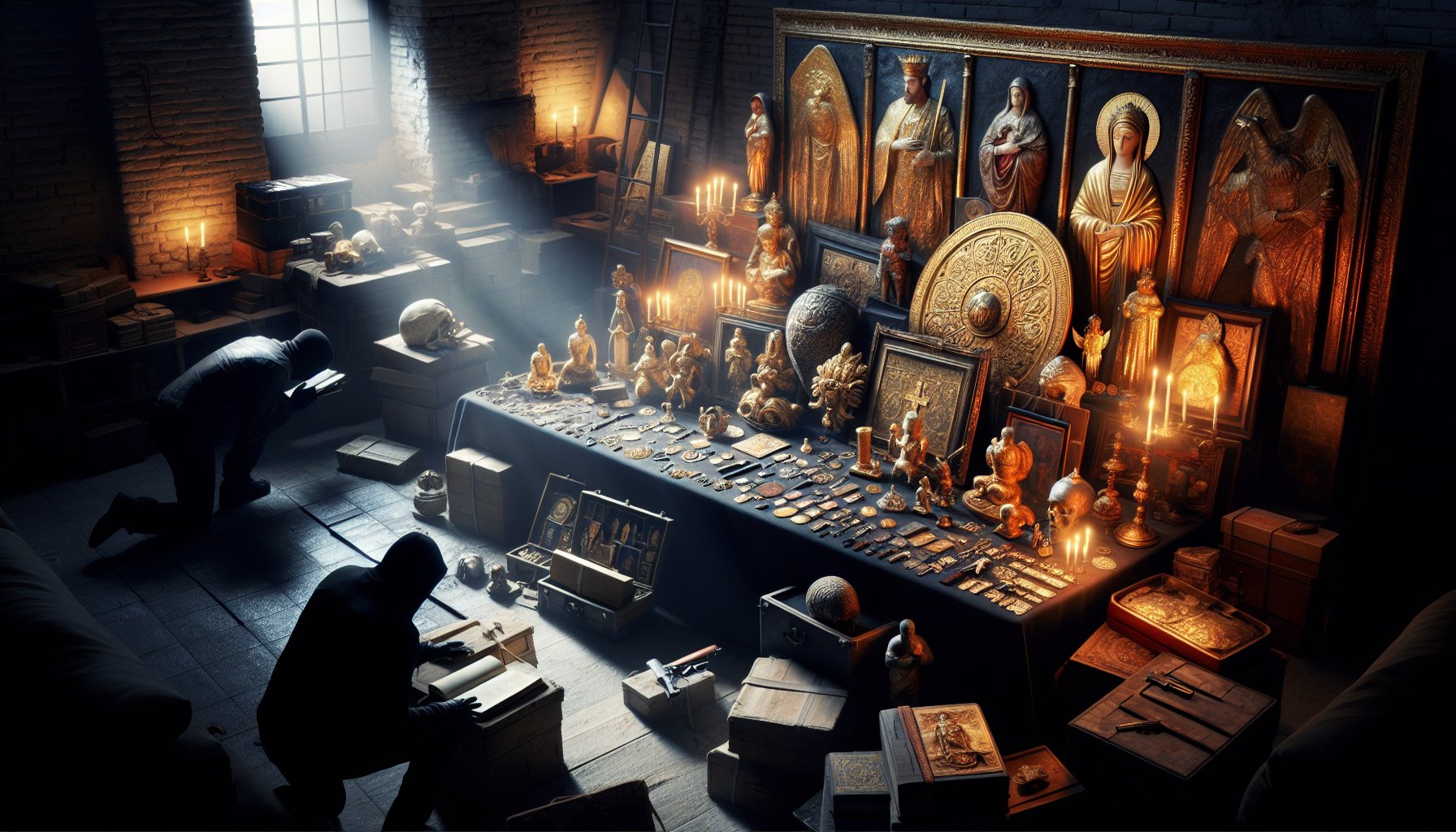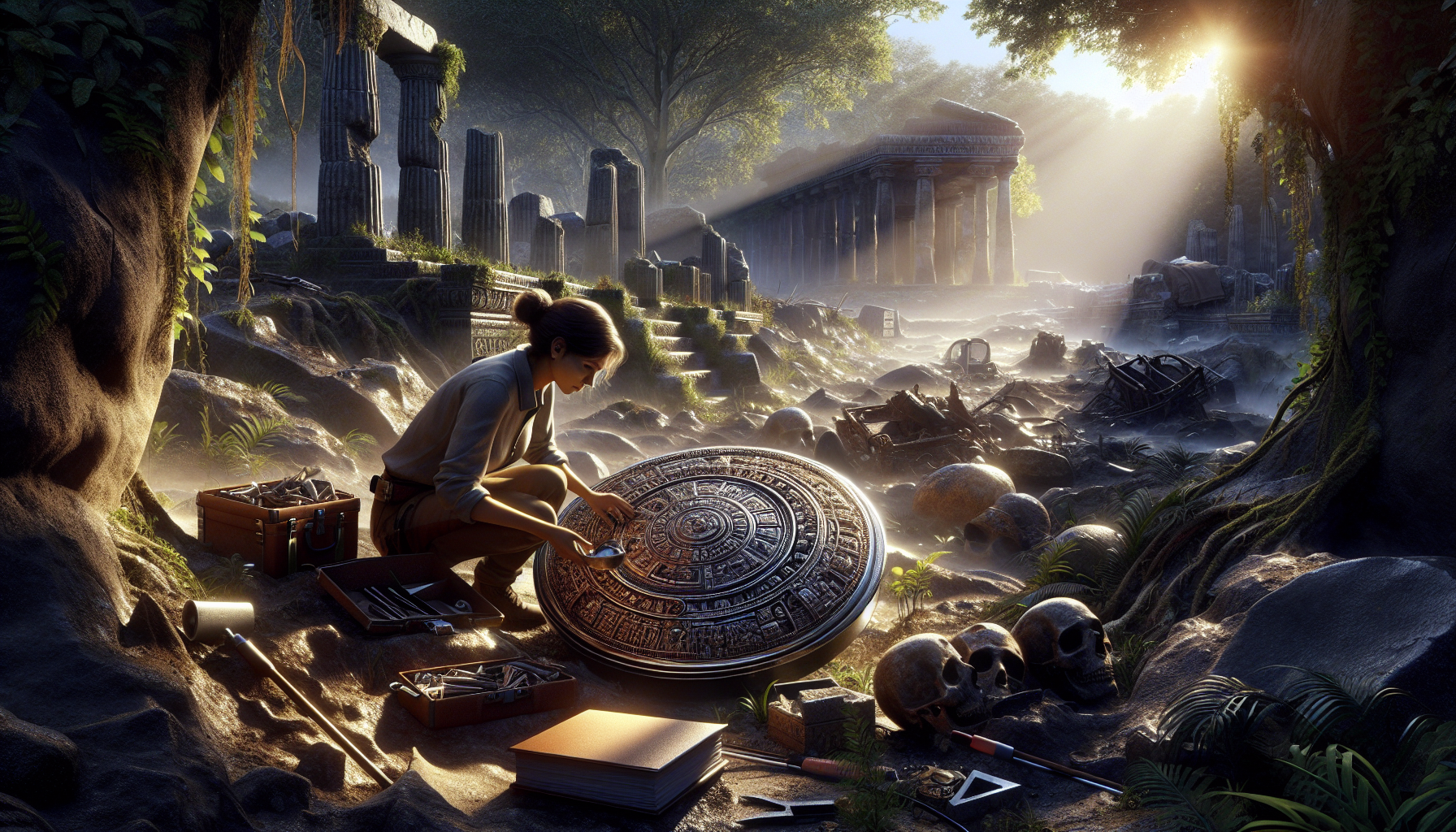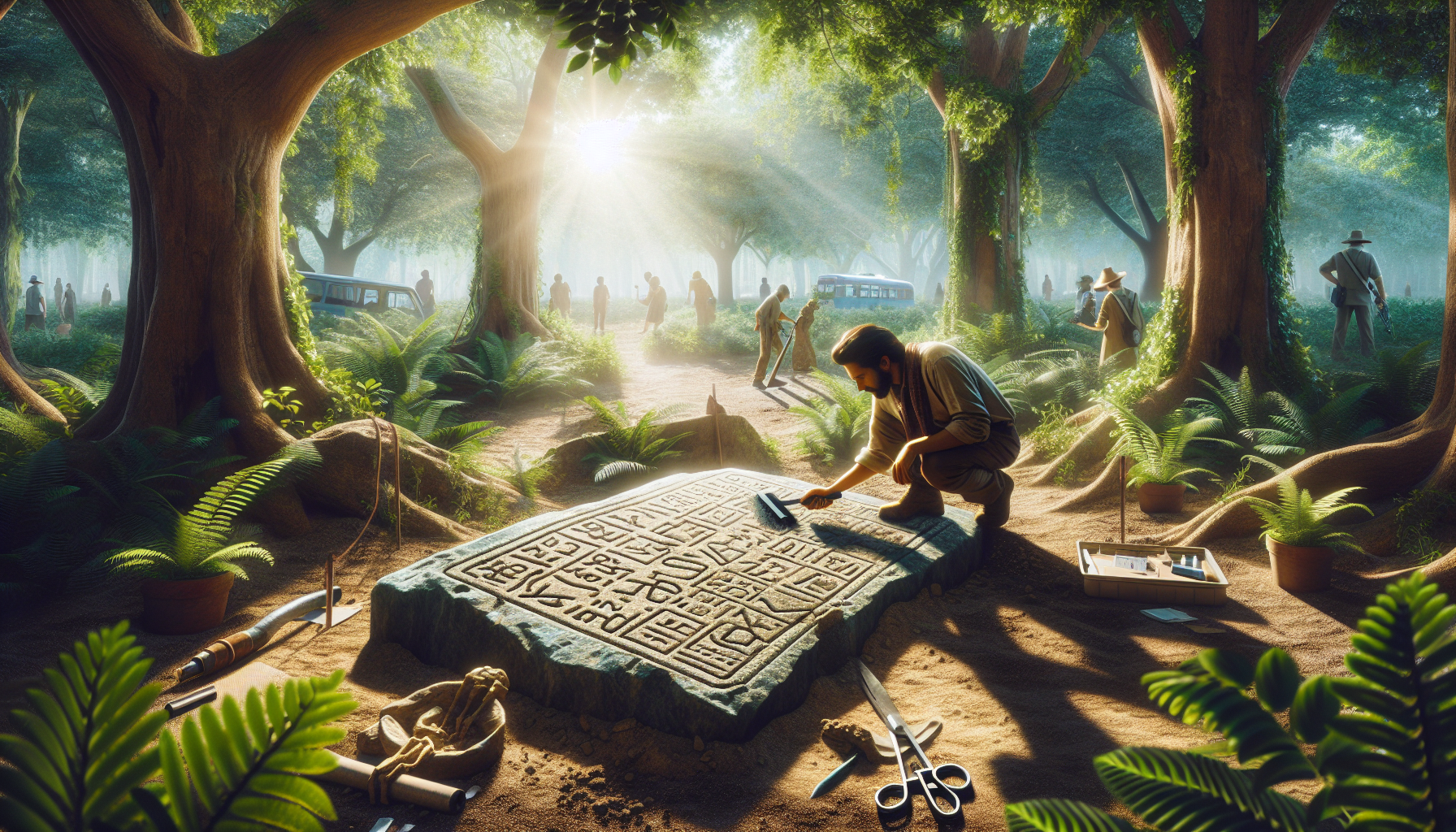In the dim corridors of history, where the lines between myth and reality blur, lie tales of treasures lost to time. These ancient relics, known only through cryptic texts and legends, evoke a sense of wonder and mystery that has captivated explorers, historians, and dreamers alike. Imagine standing on the precipice of discovery, where every clue unearthed holds the potential to rewrite history and every whispered rumor could lead to untold riches or profound knowledge. 🌍🔍 This is the allure of lost treasures, the siren call that has driven countless quests across deserts, jungles, and oceans in search of what was once thought to be mere fiction.
In this digital age, when information is at our fingertips, the fascination with these enigmatic relics endures, fueled by the tantalizing possibility that some secrets of the past remain hidden just beneath the surface. But what exactly are these treasures we seek? Why do they hold such sway over our imaginations? From the fabled riches of El Dorado to the long-lost library of Alexandria, the stories of these elusive artifacts are as diverse as the cultures they come from. Each tale offers a glimpse into the societies that revered them, the technologies that created them, and the forces that led to their disappearance.
Our journey into the world of lost treasures will unravel these mysteries, guiding you through a labyrinth of historical intrigue and archaeological sleuthing. We’ll explore the various reasons these treasures vanished, whether through natural disasters, human conflict, or the relentless march of time. You’ll discover how modern technology, like satellite imaging and ground-penetrating radar, is revolutionizing the hunt for these ancient artifacts, bridging the gap between past and present. And as we delve deeper, we’ll examine the ethical dilemmas faced by those who seek to recover what was lost, balancing the desire for discovery with respect for cultural heritage.
The pursuit of lost treasures is not merely about finding gold or gems; it’s a quest for knowledge, a yearning to connect with our ancestors and understand the world as they did. These relics, hidden in the annals of time, serve as silent witnesses to the grandeur and folly of ancient civilizations, each with a story to tell. As we uncover these narratives, we gain insights into the values, beliefs, and innovations of the people who once walked this earth. Through their artifacts, we glimpse their triumphs and tragedies, their daily lives and cosmic dreams, painting a richer picture of human history.
Join us as we embark on this odyssey, a journey that transcends time and space, where the past whispers secrets to the present and the promise of discovery beckons like a lighthouse in the storm. Whether you’re a seasoned historian, an adventurous spirit, or simply someone with a curiosity for the unknown, this exploration of lost treasures will inspire you to question what we know and dream of what still lies waiting to be found. 🌟🗺️ So, pack your metaphorical bags, and prepare to set sail into the vast, uncharted waters of history’s greatest mysteries.
The Allure of Lost Treasures
The fascination with lost treasures and ancient relics has captivated human imagination for centuries. These artifacts, often shrouded in mystery, are known to us only through ancient texts and historical accounts. The allure lies not just in the potential monetary value of these treasures but in the stories and cultural significance they embody. These relics provide a tantalizing glimpse into civilizations long past, offering insights into their beliefs, technologies, and way of life.
Many of these treasures have been lost to time due to natural disasters, wars, or simply being buried under layers of history. As such, they remain a subject of intense curiosity and speculation among historians, archaeologists, and treasure hunters alike. The pursuit to uncover these lost relics is often a race against time, as environmental factors and human activity continue to threaten their preservation.
Some of the most famous lost treasures include the legendary El Dorado, the city of gold believed to be hidden in the jungles of South America, and the Ark of the Covenant, said to hold the stone tablets inscribed with the Ten Commandments. These treasures are not just about wealth; they are a testament to human ambition and the enduring quest for knowledge and understanding of our past.
The Role of Ancient Texts
Ancient texts play a critical role in guiding modern explorers and researchers in their quest for these lost treasures. These documents, whether they are historical records, religious texts, or even myths and legends, provide clues and narratives that have fueled many expeditions. The reliability of these texts, however, varies greatly, and interpreting them requires a careful balance of skepticism and belief.
One of the challenges faced by researchers is the translation and interpretation of these ancient scripts. Over the centuries, languages have evolved, and many texts are written in dialects that are no longer in use. This necessitates the involvement of linguists and historians who can decipher and provide context for these writings. Furthermore, the symbolic and allegorical nature of some texts adds another layer of complexity to their interpretation.
Nonetheless, the stories within these texts are invaluable. They provide a narrative framework that can be cross-referenced with archaeological findings and other historical data. For example, Homer’s “Iliad” was long considered a work of fiction until Heinrich Schliemann discovered what he believed to be the ruins of Troy, lending credence to the idea that there is truth in ancient storytelling.
Iconic Lost Treasures and Their Historical Significance
Throughout history, numerous treasures have been lost, each with its unique story and significance. These relics are often intertwined with the rise and fall of civilizations, carrying with them the secrets of the past. Let’s explore some of these iconic lost treasures and the impact they have had on both history and modern-day exploration.
El Dorado: The Mythical City of Gold
El Dorado, often depicted as a city or a kingdom overflowing with gold, is one of the most famous lost treasures. The legend of El Dorado originated with the Spanish explorers in the 16th century, who were lured by tales of immense wealth in the New World. Despite numerous expeditions into the Amazon rainforest, the exact location of El Dorado remains a mystery.
The significance of El Dorado goes beyond its material wealth. It symbolizes the European quest for expansion and conquest during the Age of Discovery. The pursuit of El Dorado led to the exploration and mapping of vast regions of South America, shaping the geopolitical landscape of the continent. Additionally, the legend has had a lasting cultural impact, inspiring countless works of literature, films, and art.
The Ark of the Covenant
The Ark of the Covenant is a biblical artifact said to contain the stone tablets inscribed with the Ten Commandments. According to the Bible, the Ark was housed in the Temple of Solomon in Jerusalem but vanished after the temple’s destruction. The whereabouts of the Ark have been the subject of speculation and intrigue for centuries.
The Ark holds immense religious significance for Judaism and Christianity, representing God’s covenant with the Israelites. Its loss is not only a historical puzzle but also a theological mystery that has captivated religious scholars and archaeologists alike. Various theories suggest the Ark may be hidden in Ethiopia, among other locations, but its true location remains elusive.
| Treasure | Description | Current Status |
|---|---|---|
| El Dorado | Mythical city of gold believed to be in South America. | Still undiscovered |
| Ark of the Covenant | Biblical artifact containing the Ten Commandments. | Unknown location |
The Hunt for Lost Treasures: Modern-Day Explorations
Today, the search for lost treasures continues to intrigue and inspire adventurers and scholars. With advances in technology, modern-day explorers have tools at their disposal that previous generations could only dream of. These technologies have revolutionized the way we approach the search for ancient relics, making it more efficient and potentially more rewarding.
Technological Innovations in Treasure Hunting
The advent of satellite imagery, ground-penetrating radar, and sonar mapping has transformed the field of archaeology and treasure hunting. These technologies allow researchers to explore areas that are otherwise inaccessible or too dangerous for traditional excavation methods. For instance, satellite imagery can reveal ancient roadways and structures buried under dense forests or sand dunes, providing valuable leads on where to dig.
Ground-penetrating radar (GPR) is another game-changer, allowing archaeologists to detect buried artifacts without disturbing the soil. This non-invasive method is particularly useful in sites of cultural or historical importance where preservation is a priority. Similarly, sonar mapping has enabled the exploration of underwater sites, leading to discoveries of shipwrecks laden with treasure.
Despite these technological advancements, the search for lost treasures is not without its challenges. Many potential sites are located in politically unstable regions or environmentally sensitive areas, making exploration difficult and sometimes dangerous. Moreover, the interpretation of data from these technologies requires expertise and can often lead to false positives, adding another layer of complexity to the treasure hunt.
Ethical Considerations in Treasure Hunting
As the pursuit of lost treasures gains momentum, it is crucial to consider the ethical implications of such endeavors. The discovery of ancient relics often raises questions about ownership, cultural heritage, and the potential for exploitation. Who owns these treasures, and how should they be preserved and displayed?
Many countries have strict laws regarding the excavation and export of archaeological artifacts to protect their cultural heritage. However, the lucrative nature of treasure hunting has led to illegal excavations and black-market trading of these artifacts. This not only deprives countries of their cultural patrimony but also results in the loss of valuable historical context that can be gleaned from proper archaeological study.
It is essential for modern-day treasure hunters to collaborate with governments, local communities, and academic institutions to ensure that discoveries are handled responsibly. This includes adhering to legal regulations, respecting cultural sensitivities, and prioritizing the preservation of sites for future generations.
The Impact of Lost Treasures on Modern Culture
The allure of lost treasures extends beyond the realm of history and archaeology, permeating modern culture and media. From blockbuster movies to best-selling novels, the stories of ancient relics have captivated audiences worldwide, influencing how we perceive history and adventure.
Lost Treasures in Popular Media
The depiction of lost treasures in films and literature often emphasizes the thrill of adventure, the mystery of the unknown, and the conflict between good and evil. Iconic characters like Indiana Jones have become cultural symbols of the treasure hunter, blending fact and fiction in a way that engages and entertains.
These stories often draw on real historical events and artifacts, adding a layer of authenticity and intrigue. For example, the “National Treasure” movie series incorporates elements of American history and Freemasonry, weaving a narrative that is both educational and exciting. Similarly, novels like Dan Brown’s “The Da Vinci Code” explore religious and historical themes, sparking discussions and debates about the interpretations of historical texts and artifacts.
While these portrayals are dramatized for entertainment, they play a significant role in shaping public interest and awareness of historical and archaeological endeavors. They inspire new generations to pursue careers in history, archaeology, and related fields, ensuring that the quest for lost treasures continues.
The Cultural Significance of Lost Treasures
Beyond their entertainment value, lost treasures hold cultural significance as they embody the achievements and values of past civilizations. They serve as tangible connections to our shared human history, reminding us of the complexity and diversity of cultures that have come before us.
The discovery of ancient relics can lead to a reevaluation of historical narratives, challenging existing perceptions and providing new insights into cultural interactions and technological advancements. For instance, the uncovering of the Terracotta Army in China provided a deeper understanding of the Qin Dynasty’s military power and artistic capabilities, reshaping our knowledge of Chinese history.
These discoveries also have the potential to foster cultural pride and identity, particularly for communities whose history has been marginalized or overlooked. By preserving and showcasing these artifacts, we honor the contributions of all civilizations to our global heritage.
Watch the video above to delve deeper into the world of ancient relics and their ongoing impact on history and culture. As we continue to explore and uncover these lost treasures, we enrich our understanding of the past and inspire future discoveries.

Conclusion
In conclusion, the exploration of “Lost Treasures: Uncovering the Mystery of Ancient Relics Only Known in Texts” has taken us on a fascinating journey through history, archaeology, and the enduring allure of the unknown. Throughout this article, we have delved into the intricate stories behind relics that have captivated humanity for centuries, drawing connections between the past and the present, and unraveling mysteries that have long lingered in the shadows of time.
One of the key points we explored is the significance of these ancient treasures in understanding the cultures and civilizations that came before us. These relics, often only mentioned in ancient texts, serve as tangible connections to our ancestors, offering insights into their beliefs, practices, and ways of life. From the legendary treasures of King Solomon to the elusive Ark of the Covenant, these artifacts are more than just historical curiosities; they are vital pieces of the human story that continue to intrigue scholars and enthusiasts alike.
Another important aspect we discussed is the role of modern technology and interdisciplinary research in uncovering these mysteries. Advances in fields such as archaeology, anthropology, and digital humanities have revolutionized the way we approach ancient texts and artifacts. Techniques like ground-penetrating radar, 3D modeling, and DNA analysis have enabled researchers to discover and interpret relics in ways that were once unimaginable. This not only enriches our understanding of the past but also highlights the importance of preserving these treasures for future generations.
Furthermore, we examined the ethical considerations surrounding the excavation and ownership of ancient relics. The debate over who has the right to possess and display these artifacts is ongoing, with arguments on both sides emphasizing the need for cultural sensitivity and international cooperation. By addressing these issues, we underscore the importance of respecting and preserving the cultural heritage of all peoples.
The discussion also touched upon the broader implications of uncovering these lost treasures. In a world that often seems disconnected from its history, these relics serve as reminders of our shared humanity and the continuous thread that links us to our ancestors. They inspire us to ask questions, seek knowledge, and appreciate the rich tapestry of human experience.
As we conclude this exploration, it is crucial to acknowledge the enduring fascination that these lost treasures hold for us. They captivate our imaginations, fueling stories, myths, and dreams of discovery. They challenge us to think critically about our history and to remain curious about the mysteries that still lie hidden beneath the sands of time.
We encourage you, dear reader, to engage with this topic further. Whether you are a seasoned historian or a casual enthusiast, there is always more to discover and learn. Share your thoughts and insights in the comments below, and consider sharing this article with others who might be intrigued by the mysteries of ancient relics. Let us continue the conversation and inspire a collective effort to uncover the truths that lie hidden in the annals of history.
In an age where information is at our fingertips, the quest to uncover lost treasures reminds us of the thrill of discovery and the importance of preserving our cultural heritage. Let these ancient relics inspire you to explore the unknown and contribute to the ongoing dialogue about our past. Together, we can ensure that the stories of these treasures are not lost to time but continue to enlighten and inspire future generations.
For further reading and research, consider exploring resources from reputable institutions such as the British Museum and National Geographic. These organizations offer extensive collections and articles that delve deeper into the world of ancient relics and their significance.
In closing, may this exploration of lost treasures spark your curiosity and drive you to seek out the wonders of the past. Let us cherish these relics as symbols of our shared history and embrace the mysteries that still await discovery. 🌍📜
Toni Santos is a visual storyteller and symbolic artisan whose work unearths the sacred in forgotten places — a seeker of relics not cast in gold, but in petal, vine, and stone.
Through a reverent artistic lens, Toni explores nature as a vessel for unknown religious relics — sacred echoes embedded in botanical forms, remnants of spiritual traditions that were never written but always felt. His creations are not merely decorative; they are quiet devotions, fragments of invisible altars, living prayers suspended in time.
Guided by an intuitive connection to flora and the mysteries they carry, Toni transforms botanical elements into symbolic artifacts — each one a relic of forgotten faiths, imagined rituals, or ancient wisdom left behind by time. His work invites reflection on how the divine speaks through organic beauty, and how the sacred often hides in the overlooked.
As the creative voice behind Vizovex, Toni curates collections and visual meditations that feel like lost sacred texts — poetic, intentional, and charged with quiet meaning. From floral talismans to mythic botanical studies, his work bridges earth and spirit, nature and memory.
His work is a tribute to:
The invisible sanctity found in everyday natural forms.
The mythic energy of plants as spiritual messengers.
The act of creating relics from silence, shadow, and growth.
Whether you’re drawn to mysticism, symbolic art, or the sacredness woven into the natural world, Toni invites you to explore a space where forgotten relics are remembered — one leaf, one symbol, one sacred fragment at a time.





